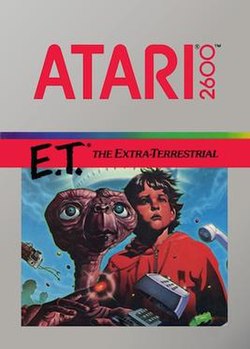Today's video takes a look at the Wayforward developed remake of Capcom's legendary NES title, DuckTales.
Saturday, November 23, 2013
Friday, November 1, 2013
The Crash Of 1983: The Price Of Greed 30 Years Later
-->
30 years ago, an event happened that could have destroyed
the gaming industry. It’s something that has made gamers nervous for years,
especially with the proliferation of games with incredibly high production
budgets and consoles that are only as good as the non gaming applications
attached to them. There have been a number of conflicting claims as far as
where to point the finger of blame for causing The Video Game Crash of 1983,
but it boils down to simple greed.
Atari had a lot of problems leading to the crash. One of
which was simple arrogance. You see, Atari did silly things on occasion like
produce more copies of a particular game than they had consoles in the market.
This was case with the Atari 2600 port of Pac Man. In 1982, when the 2600 port of Namco’s iconic title was released, Atari decided to produce 12 million copies of it. This wouldn’t have been a problem if not for one important fact: Atari only had 10 million consoles in homes. In the end, Atari sold only 7 million copies of Pac Man and was faced with legions of angry fans who sought refunds after playing the incredibly subpar port of Pac Man.
This was case with the Atari 2600 port of Pac Man. In 1982, when the 2600 port of Namco’s iconic title was released, Atari decided to produce 12 million copies of it. This wouldn’t have been a problem if not for one important fact: Atari only had 10 million consoles in homes. In the end, Atari sold only 7 million copies of Pac Man and was faced with legions of angry fans who sought refunds after playing the incredibly subpar port of Pac Man.
Pac Man wasn’t the only miscue Atari faced, and the next one
was one of legendary proportions. When the movie E.T. was released in the
summer of 1982, Warner Communications, who owned Atari, demanded that a video
game based on the film be available in stores by Christmas. Atari was given a
mere six weeks to see a video game through from concept to store shelf. The
resulting game was what many consider the worst video game ever made. Again,
Atari was left with millions of unsold cartridges, which they took to a
landfill in New Mexico, destroyed, and covered by cement. The “Atari Landfill”
as it became known over the years has become something of an urban legend among
younger gamers, but is all too familiar to us old enough to have seen the
catalogs with 1 cent sales on 2600 cartridges.
Finally, there may have been way too many crappy games and
random consoles on the market. In 1982, Atari had two consoles and two
computers on the market. Also, several companies had consoles that played Atari
2600 games, several other game consoles and computers, and games available for
all of them. It was incredibly confusing and left many gamers and their parent
not even wanting to be bothered. This led to store being flooded with stock
hogging shelf and stockroom space. As a result, the average parent could buy
their kid an Atari 2600 for $30 and games for $1-$5. The losses were monumental and in 1983, many companies either
abandoned their video game divisions, or went out of business.
The Crash of 1983 was something that many younger gamers
never heard of, but that doesn’t make it any less real. The fact is, some of
the problems that damaged the industry them, most notably flooding the market,
is definitely happening now with titles being released on an almost yearly
basis. If the gaming industry were to crash again, I’m hard pressed to think it
would recover. There are those who have pondered the validity of console gaming
with the rise of gaming on devices not typically designed for it, like phones
and tablets, but as console gaming goes, so does gaming on PCs and mobile
devices. If this upcoming generation of consoles falters, then who can assume
that anyone would be willing to stay the course with those other devices.
The evidence that gaming may be slowing down or that gamers
are just getting tired of playing the same games over and over may be the fact
that in one particular month a single game, Grand Theft Auto V, accounted for
nearly half of all video game sales on the market. While Atari would have
killed for this to happen with Pac Man or E.T it does point to a problem in
gaming. Gaming can ill afford to repeat the events that led to the Crash of
1983, but simple human greed could lead to history repeating itself.
Unfortunately, There may not be any room for a new Nintendo to rise from the
ashes and save the art form that we have grown to love.
Labels:
1983,
Atari,
E.T.,
Industry Crash,
Pac Man,
retro gaming
Subscribe to:
Posts (Atom)



